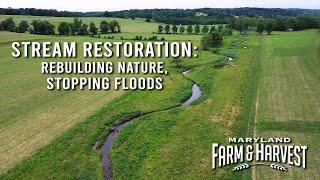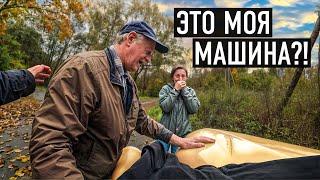
Stream Restoration: Rebuilding Nature, Stopping Floods | Maryland Farm & Harvest
Комментарии:

As a guy who grew up in the 20 the century I can tell you the old timers would of told you to F off....in the best of circumstances
So these are things that we can do today we couldn't do then,

Glad to see a couple humans waking up
Ответить
Now add native trout
Ответить
I built this stream!
Ответить
Now how to actually fix Baltimore City?
Ответить
God, get a beaver and call it a day. Stop trying to engineer your way out of a problem you created.
Ответить
bring in a family of beavers and really watch this stream becaome amazing.
Ответить
Farmers have been destroying streams like that a lot longer than 100 years. Keep the stupid horses and cows out of the stream does a lot.
Ответить
The stream is cool and all, but monoculture is doing way more soil damage than anything else.
Ответить
Its not new sience ......100years ago a few people still new theese things because they learned that as kids so ......not new the austrian Viktor schauberger who worked alot with the mysteries of water talked about this alot .....here in Germany this is old knowledge too ......its been ignored too but its there
Ответить
This is absolutely ridiculous, the yanks kill the animal that would do this naturally.
Ответить
That creek collecting all those heavy chemicals using on those corps and contribute into the reservoirs; yet they call it ''nature friendly'' approach.
Try harder.

imagine spending loads of money and effort to change what mother nature gave you for free and then spending loads of money and effort to eventually change it back.
when are people EVER going to learn that Mother Nature ALWAYS does it best.

Awesome
Ответить
Pathetic
Ответить
It's good to see someone learning to live with their land properly, sharing rather than trying to order it. The US in particular though has a very long way to go before they start to recover from the damage inflicted by previous generations. It's a criminal shame they didn't learn from their First Nation people instead of trying to exterminate them.
Ответить
it was the same "experts" who taught them to straighten the canels to get more arible land, the same wisdom to plow straight up the slope
Ответить
Yall hiring?
Ответить
in the Netherlands we also use summer dike and winter dike system to store abundance of mass, this project is looking really good developed, I would ad ponds to create storage.
although it is looking great, so maybe me being a twat

Good stuff! Onwards and upwards!
Ответить
Shaking my head at all the beaver comments. Beavers help make wetlands and water storage which help slow water, but they do not reshape rivers like this. This work quickly reintroducing bends and removing 5ft embankments , etc.
Ответить
In the U.K. they put in hill drains, big mistake , water rushes off the hill dumps sediment on spawning gravel and causes flooding, now they take them out, the answers is leave the old rivers and streams and land drainage well alone, unless they have been “improved”. Good job being done in the USA here.
Ответить
In Brazil, there are laws protecting the original bed, banks and forests around every creek or river in the country. Unfortunetly, only farmers respect those laws, while in urban areas, people just don't pay attention to that.
Ответить
A great example of how we are being smarter now, then 70-80 years ago when our forefathers made those significant changes to our environment. It’s great to see that in the United States you are making a huge effort to undo some of those damages. I wish, we, here in Germany, would be as smart as well. We had a huge flooding in 2021 and are facing very much similar issues. Definitely an example to share here, too!
Ответить
This calls for a full 2 hour review of the project. Every aspect seems fascinating. Design, engineering, how to adapt farming and livestock usage to the new low path.
Ответить
Very inspiring! Does that stream flow all year round?
Ответить
Very informative
Ответить
We need more of this in the world. Thank you, god bless
Ответить
If you must continue monoculture practices, at least do what is being done here. Leave ample space for the stream to wander and/or flood as it would under natural conditions. This space is also critical for birds, reptiles, insects (honey bees), amphibians and other animals that we need to share this planet with. I like the use of large pavers for equipment crossings rather than using culverts which are prone to clogging, etc and require maintenance. I wish all farmers were as smart as the folks at Willow Oaks Farm.
Ответить
weird how they're like: "we're catching up with what mother nature use to do and it worked great before we started exploiting everything"
Ответить
I wonder if companies like this use, or even consider using, biochar in their banks. This would help filter and lock away any nutrient runoff while adding strength to the banks due to faster root formation and added soil life. Also, this would be an additional carbon sink that couples with the natural sink action of the wetlands.
Ответить
Hi from Frederick MD !! How does one get into this business, what kind of education ? I LOVE this and would LOVE to be involved in doing this myself, or even to help in the very least.
Ответить
3:47 am i tripping or does he look green screened in
Ответить
Incredible job
Really fantastic 👍

I always love that when I see this type of restoration projects to preserve mother nature❤️
Ответить
Small rivers can be cleaned from bottom sediments using a motor pump for dirty water and a suction nozzle Bagermaster. A mini dredger consisting of a motor pump and a suction nozzle allows you to deepen small rivers by removing sediment from sand and silt
Ответить
Beavers are nature’s flood and drought control, reintroducing them to streams is an efficient way to bring back natural stream beds.
Ответить
Even better would be to plant native saplings along the banks. That will increase root binding of the soil, increase nutrient filtration, and cool the water, all of which will improve the natural habitat for stream life.
Ответить
Man working with nature as opposed to man "battling" nature seems to be a much better prospect all round.
Ответить
I am born in the 80s and grew in 90s and I remember small streams everywhere in villages. They are all shut now and the places we live look sterile. Those tiny rivers healed nature and brought life to the place with animals, birds and insects.
Ответить
Did they clean out the pond behind the house on jarrettsville pike? What about the stream across the jarrettsville pike in middle of the field? Are they still running the waterwheel at the dam that feed the pond below the barns?
Ответить
3021 Jarrettsville Pike and Hess Road
Ответить
Back in the 80, the owner had the state of md recommend planting trees along all the creeks and put up electric fences to keep the cows out of the water, now they lease the land and plant and spray the crops, what is worst manure or crop spray
Ответить
Why doesn't stream restoration projects start at the source of the rainwater runoff? Building small dams where the rainwater runoff comes off the farmer's fields allows the rainwater to soak into the groundwater. Contour farming also holds back the rainwater runoff to soak into the groundwater. A lot of endangered species nest and hibernate over winter in dirt streambanks, female bumblebees, Eastern Massasauga Rattlesnake, Blanchard's Cricket Frog, bank swallows nesting holes, kingfisher's nesting holes, etc.
Ответить
Water must move like snake movement for better water retention and good soil management.
Ответить
Which slows down water energy by bringing the necessary resustence naturally.
Ответить
My farm is larger than this I struggle to afford to do this
Ответить
wrong - see the truth about stream restoration projects (Utube: "How a stream is restored in Gaitherburg").
Ответить
Nice work...
Ответить
Good work!
Ответить

























